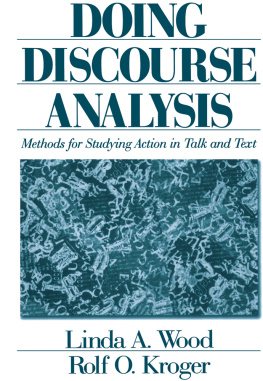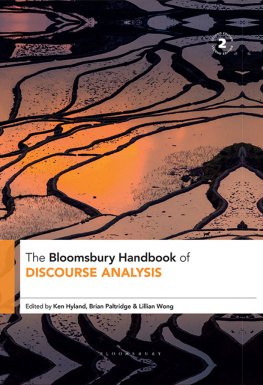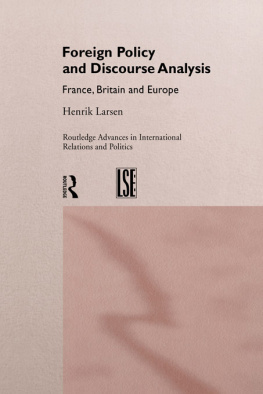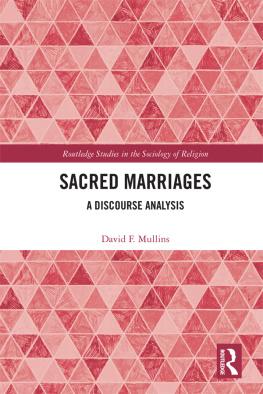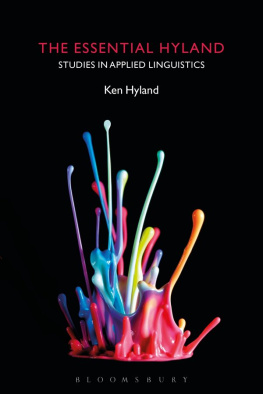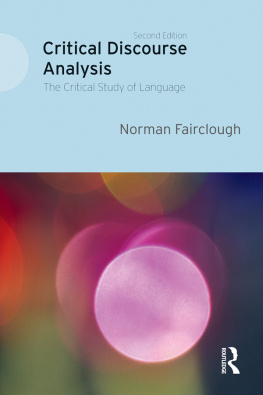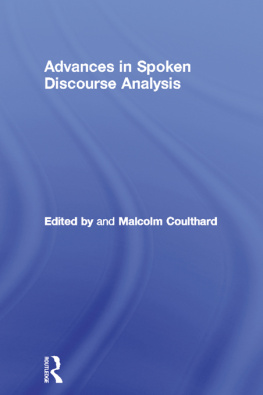Copyright 2000 by Sage Publications, Inc.
All rights reserved. No part of this book may be reproduced or utilized in any form or by any means, electronic or mechanical, including photocopying, recording, or by any information storage and retrieval system, without permission in writing from the publisher.
For information:
 | SAGE Publications, Inc.
2455 Teller Road
Thousand Oaks, California 91320
E-mail: |
Sage Publications Ltd.
I Olivers Yard, 55 City Road
London HC1Y ISP |
SAGE Publications India Pvt Ltd
B-42 Panchshecl Enclave
PO Sox 4109
New Dehli 110 017 |
Printed in the United States of America
Library of Congress Cataloging-in-Publication Data
Wood, Linda A.
Doing discourse analysis: Methods for studying action in talk and text / by Linda A. Wood, Rolf O. Kroger.
p. cm.
Includes bibliographical references and index.
ISBN 0-8039-7350-0 (acid-free paper) ISBN 0-8039-7351-9
(pbk.: acid-free paper) 1.
Discourse analysis. I. Kroger, Rolf O. II. Title.
P302.W66 2000
401.41dc21 00-008063
04 05 06 7 6 5 4
| Acquiring Editor: | Margaret H. Seawell |
| Editorial Assistant: | Sandra Krumholz |
| Production Editor: | Astrid Virding |
| Editorial Assistant: | Victoria Cheng |
| Typesetter: | Tina Hill |
| Indexer: | Terri Greenberg |
| Cover Designer: | Candice Harman |
Introduction
What most people do most of the time is talk a lot. To do anythingto build a boat, to launch a rocket, to start a war, to begin a love affair, to initiate a divorcerequires talk and, often, texts. And then more talk. Talk is what moves the world, both in the private and public spheres. Darling, I love you moves events along, sometimes with fateful consequences, such as divorce and custody battles. Almost all we do is accomplished by talk. To punch another person out is to regress to uncivilized conduct. War has been described as the continuation of diplomacy by other means; it, too, is a retreat from civilized conduct. It is sometimes said that talk is cheap but talk is always better than pushing and shoving. Talking protects us from the often horrendous consequences of aggressive physical action. Physical moves can also be good, as in romantic encounters, but they too are often brought about and accompanied by talk.
Nevertheless, we still know relatively little about talk. Historically, the social sciences have concentrated on correlations between abstract social conditions and isolated aspects of the behavior of groups or individuals (e.g., suicide, aggression, prejudice). Until very recently, little attention has been given to what people actually say or do in particular everyday circumstances. What they do is to talk, often incessantlyabout the world, about work and play, about others (parents, spouses, friends, bosses, colleagues, etc.) and their relations with them. And, in talking, they do things. That was Austins (1962) revolutionary insight into an aspect of language that had not been fully recognized, the pragmatic function of language, what language does to make social life as we know it possible. Before Austin, social scientists had concentrated on the descriptive or literal function of language, how it transmits information. That function has its own importance, but it is not the whole story.
The story involves a fundamental shift in the social sciences that started some time ago (principally, with Wittgensteins philosophy of psychology and language in the 1950s), although this shift had a major impact on the practice of the social sciences only in the 1980s. This change promises an advance in our understanding of the human condition, comparable to other turning points in intellectual and cultural development. The shift we are talking about has been called the turn to language in recognition of what is most uniquely human, the power of language and the possibilities it affords in the understanding of social life. It amounts to a celebration of what is uniquely human as opposed to the biological grounding of human nature: the contrast between the fully realized cultural being (Harr, 1979) and the social animal (Aronson, 1992).
The turn to language, or to discourse, as it has come to be known (Kroger & Wood, 1998), has had the salutary effect of breaking down the artificial barriers between the various social science fields concerned with the analysis of everyday social life. Investigators and students have come from communication research, social psychology, linguistics, sociology, anthropology, philosophy, English literature, political science, and other disciplines. They have come to meet at joint international conferences, and they publish in both specialized and interdisciplinary journals to forge a new area of inquiry.
The turn to discourse has been accompanied by the development of new methods, and these methods are primarily what this book is about. The methods are designed for the close analysis of talk and, of course, writing. The methods are sometimes called discourse analysis, but discourse analysis as we view it is not only about method; it is also a perspective on the nature of language and its relationship to the central issues of the social sciences. More specifically, we see discourse analysis as a related collection of approaches to discourse, approaches that entail not only practices of data collection and analysis, but also a set of metatheoretical and theoretical assumptions and a body of research claims and studies (Potter, 1997). Data collection and analysis are a vital part of discourse analysis, but they do not, in themselves, constitute the whole of discourse analysis.
The reader may well ask: Do we need yet another set of methods? The social sciences already have a wide variety of methods. Most are mundane because of their very pervasiveness (e.g., interviews, questionnaires, surveys, multivariate analysis), and some are highly esoteric in being confined to a small circle of specialized practitioners (e.g., the Rorschach inkblot). The short answer to our question is a resounding yes; a longer answer necessarily takes us a bit farther afield, to a consideration of discourse analysis as a conceptual enterprise. The turn to language has also involved changes in the conceptual framework underlying contemporary inquiry into human behavior. We pause here to look briefly at these changes and their implications for the modes and methods of inquiry.



